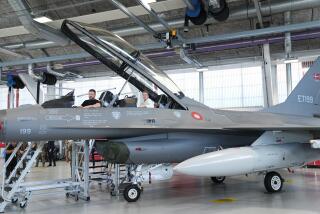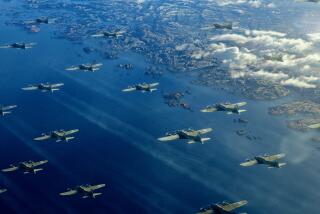Taking Back Seat in Ride of Life
SUMTER, S.C. — “OK Eric, no turning back,” Capt. Randy Redell warned on his intercom as the bubble canopy of the F-16 fighter jet locked into place.
The F-16 took off at 10:30 a.m. from Shaw Air Force Base, afterburners blazing. It was like riding atop a rocket ship.
In 47 seconds, the jet zoomed from sea level to 18,000 feet, the nose pointed straight up. There was 30,000 pounds of thrust coming from the single General Electric engine, more powerful than the starting lineup of the Indianapolis 500.
Having survived four G’s--four times the force of gravity--my confidence was soaring. Then came the nine-G’s left turn.
My whole body went numb. I was jammed into the cockpit as if a Volkswagen were resting on top. My anti-G suit inflated; my stomach churned. My face was contorted and my forehead was drenched in sweat as I took deep breaths from my oxygen mask. No ride at Disneyland or Magic Mountain could ever prepare me for a nine-G experience.
Never wincing once was Redell, the 30-year-old pilot who played quarterback at Crespi High and graduated from the U.S. Air Force Academy.
“All that time on the football field prepares you for things like this,” he said while trying to reassure his terrified passenger. “This is like riding on a magic carpet or riding at the end of a broom stick. I’d do this seven days a week for free.”
*
As a high school student in Encino, Redell was more interested in football than flying.
“Growing up, all I ever wanted to do was lead the UCLA Bruins to the Rose Bowl,” he said. “But there aren’t many 5-foot-10 1/2 quarterbacks. I went to the Air Force Academy and thank God every day. I’m addicted to flying.”
Redell started flying the F-16 in 1995. He has more than 1,100 flights under his belt. He helped enforce the No Fly Zone in Iraq. In August, he leaves for a one-year tour of duty in South Korea before returning to become an F-16 flight instructor.
“Going through high school, you never dream what you’re going to be when you grow up,” he said. “I have to hit myself sometimes because I can’t believe what I’m doing.”
It didn’t come without lots of perseverance.
“Sports got me to think this way,” he said.
In 1984, Redell’s junior football season at Crespi, the Celts went 0-9-1. Rather than looking at it as a negative, Redell turned it into a positive.
“Whether you finish dead last and lose every single game, as long as you never quit, you will eventually be successful,” he said.
He applied the same standard to flying.
“There’s been a lot of stumbling blocks along the way for me,” he said. “Overcoming the academic classes at the Air Force Academy, trying to overcome airsickness when I first started flying . . .”
Married with two young children, Redell has moved six times in his eight years of military life. He finds inspiration in his flying and from the people he works with.
“These guys are unbelievable,” he said of his fellow F-16 pilots. “One of them is convinced he’s going to be the first person on Mars.”
Redell has adopted a simple philosophy. “Shoot for the stars,” he said. “You might not ever get there, but at least you’ll get in the clouds somewhere.”
*
It’s not every day a sportswriter gets to fly in a $25 million F-16. This was made possible by the Air Force’s Orientation Flight Program.
St. Francis High football Coach Bill Redell, Randy’s father, first suggested the story. Then he tried to scare me.
“Let me tell you something--you’re going up 50,000 feet in 10 seconds,” Bill said.
Randy assured me, “I can make it as benign as flying from New York to Los Angeles or as bad as my worst football game.”
After the flight was approved, Randy wrote in a letter, “If you thought [running back] Russell White was fast, you will soon gain a new appreciation for speed and performance.”
But there was no guarantee I’d fly when I arrived at Shaw AFB last Friday unless I passed a physical and made it through a life-support training class.
The physical went well. A flight surgeon checked my heart and blood pressure and examined my ears.
“Good to go,” he said.
Then came the one-hour training class for an ejection. Yes, it was a worst-case scenario, but it was more frightening than the flight itself. I climbed into a makeshift cockpit wearing a fire-resistant flight suit, steel-toed boots, leather gloves, an anti-G suit, a harness that’s connected to the parachute, a flight helmet and oxygen mask. I was bolted down with a series of seat belts.
Then I was told about the yellow handle between my feet. If you pull it or the pilot pulls his, you’ll be shot out of the cockpit and a parachute is supposed to open. If the parachute fails, you open it manually by pulling a chord you can’t see.
“Bail out, bail out, bail out,” is the command to pull the yellow handle. Those are words I’ll never forget.
Equally ominous is trying to escape the jet while on the ground. That cue is, “Egress, egress, egress.”
I was shown how to release all of my belts and connections. Getting off the oxygen mask was hard enough, let alone disconnecting my parachute harness in an emergency. But eventually I did it.
“Good to go.”
*
Twenty-eight F-16 Fighting Falcons from the 78th Fighter Squadron are lined up. It’s a hot, humid morning, and the noise is deafening. Earplugs are necessary as several F-16s taxi to the runway for takeoff.
Largely unseen is the meticulous preparation required before an F-16 leaves its blocks.
“We just don’t go out there and jump in,” Redell said.
Each aircraft has a crew chief and assistant. Even in 100-degree temperatures, workers must crawl into a huge in-tank carrying a mirror looking for any cracks in the fan blades after a flight.
“They have the lives of the pilots in their hands,” Redell said. “They are the unsung heroes.”
There are briefings before missions, a review of videos after missions, strategy sessions, intelligence sessions, training sessions.
It’s a total team operation, just like football. But the stakes are much higher.
“It’s a deadly serious game,” Redell said.
*
The scenery is stunning. I’m looking out the bubble canopy. We’re cruising at 10,000 feet, giving the illusion of an eagle soaring above the clouds.
“You are flying in the most maneuverable fighter in the world,” Redell said.
Great, but no more nine-G turns, thank you.
The F-16 has an air-conditioning system so powerful Redell jokes “it can spit out ice cubes.”
Our jet call sign is Bowa 61. Now it’s time for the supersonic run. There’s a brief G force, then it goes away. We break the sound barrier, zooming past Mach 1 traveling faster than 725 mph. Redell informs me there were test pilots killed trying to do what we just did.
Then he lets me fly the jet. That lasts about 10 seconds, thank goodness. The control stick of an F-16 is so sensitive it moves only one-eighth of an inch. I try to maneuver it like a joy stick, then quickly decide to leave the flying to Redell to avoid testing out my parachute skills.
Soon, we do a loop, then go on a practice bombing run at a nearby range.
After a breathtaking 82 minutes in the air, we land. It’s a smoother landing than my commercial flight into South Carolina. I completed the F-16 flight without having to use the disposable plastic bags in my fighter suit, thanks to my wise decision to skip breakfast.
Through the years, I’ve walked along the Great Wall of China, snorkeled at the Great Barrier Reef, inspected Lenin’s Tomb and visited John F. Kennedy’s grave at Arlington National Cemetery. Nothing compares to the simultaneous thrill and terror of an F-16 flight.
Every day, an entire nation places its trust in people like Capt. Randall J. “Rags” Redell to be ready when called upon. The training and preparation pilots undergo is astonishing.
One unforgettable F-16 flight was enough for me, though. Especially after Redell revealed, “My preferred altitude position is upside down.”
*
Eric Sondheimer’s local column appears Wednesday and Sunday. He can be reached at (818) 772-3422.
More to Read
Go beyond the scoreboard
Get the latest on L.A.'s teams in the daily Sports Report newsletter.
You may occasionally receive promotional content from the Los Angeles Times.











